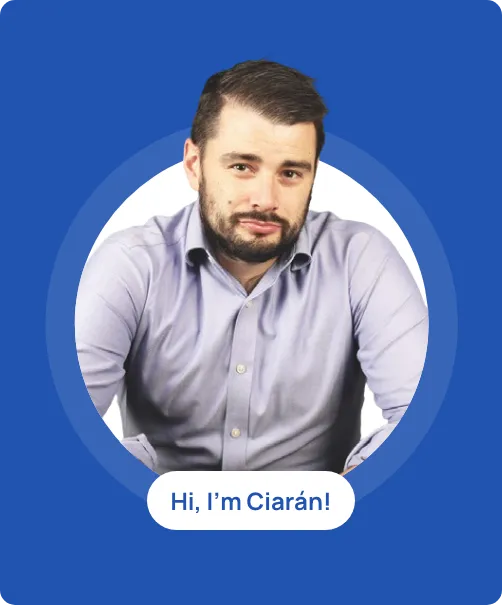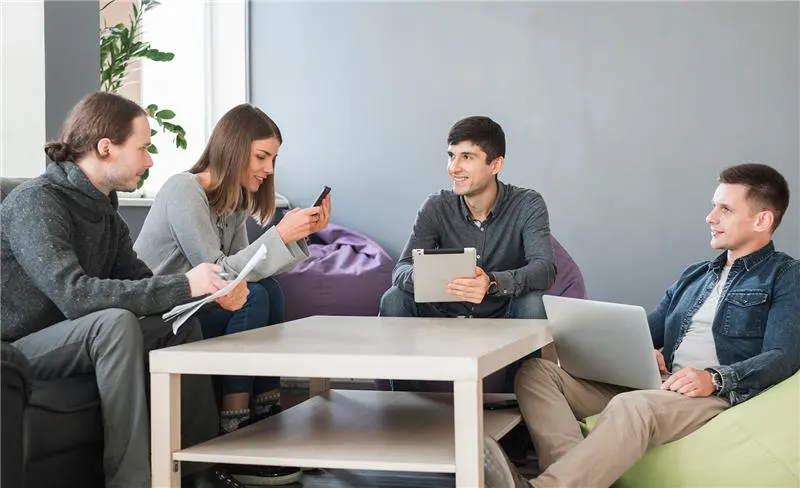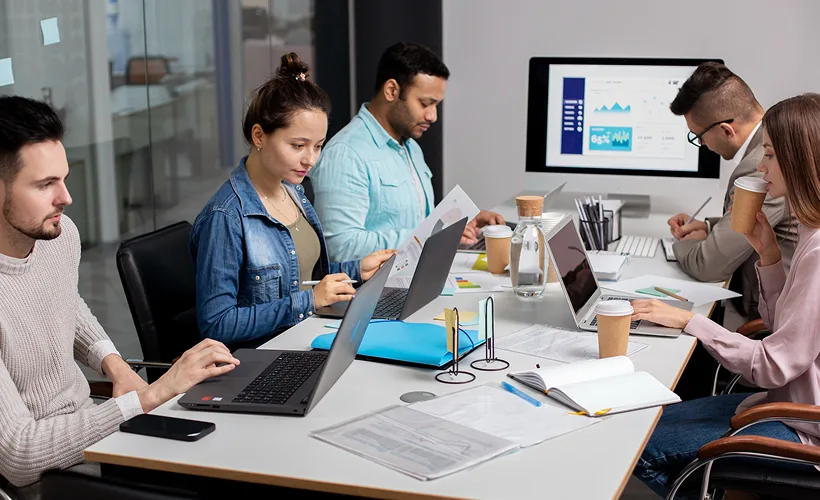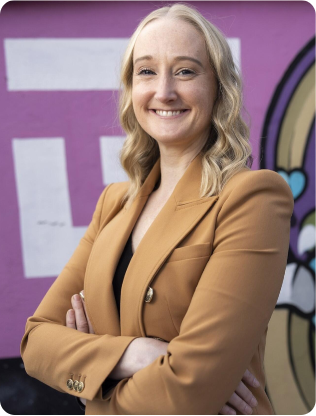Getting started with Blockchain development? Check this complete guide.
Published on: December 01, 2022
The use of blockchain technology in mobile app development has increased the speed and security of online transactions. The worldwide expenditure on blockchain solutions by 2024 is expected to reach around $19 billion.
Aside from boosting venture capital funding for blockchain development firms, rising blockchain demand will impact the price of blockchain apps. Blockchain applications are decentralised, and shared databases, enabling all users to access information. Mobile app development companies are leveraging blockchain architecture to create apps.
In a conventional app, user information is saved in one place. All the information could be at risk if the server is hacked. However, since blockchain apps store their data across numerous nodes, it's much more difficult for hackers to access.
Blockchain applications are more rapid and efficient than conventional ones. There is no need for a governing body to sanction each financial deal. The information is saved in blocks and cannot be altered once added to the chain.
Thus, blockchain keeps unalterable and dedicated records of each transaction for the mobile app.
There are two types of blockchain applications —
Permissioned blockchains: A blockchain that allows authorised users to carry out actions is known as a permissioned blockchain.
Permissionless blockchains: A permissionless blockchain is one where users connected to the blockchain network can carry out appropriate actions and communicate with other users.
Getting Started with a Blockchain App Development
It's always best to have a solid understanding of the fundamentals and what to anticipate during the process, whether you opt to handle your blockchain development internally or outsource to a reputable business.
The step-by-step instructions will walk you through our careful approach to building blockchain applications for our customers.
Step-by-step process to build a Blockchain app!
Ideation
You must decide whether your concept requires blockchain and the use cases for your application. Remember that blockchain verifies transactions and encrypts data; if it is not properly built, it cannot provide other transaction security.
Once you've concluded that blockchain technology is necessary for your project, you must involve blockchain app developers. Also, it is best to determine how your blockchain app can add value to users and what sets it apart from similar offerings.
Blockchain app development ideation also involves deciding the features to implement as separate business entities on and off the blockchain. Plan for the product's future releases, including beta and final software versions.
The outcome at this stage is a hypothetical workflow and blockchain architecture. This should help choose from secure or open networks for developing the app.
Have control over programming language
Now, the network you utilise depends on the use case of your blockchain application (such as the required transaction speed and prices). When selecting a blockchain development company, the programming language can differ based on the smart contract network. Therefore, lookout for blockchain developers who master the programming language necessary for running the application.
For instance, the Solidity programming language, a high-level, object-oriented language developed by the Ethereum team that resembles JavaScript, is used to generate Ethereum smart contracts. On the other hand, Rust, C, and C++ are all part of Solana's technology stack for deploying smart contracts.
Pick your blockchain platform
Once you have an application idea and programming language on which to base your application, pick a blockchain platform you want to construct. Before deciding which is best for your use case, you should get familiar with the many available options. Corda, Hyperledger Fabric, and Ethereum are the most popular. Let’s check them out.
Ethereum
Ethereum is a well-known platform that aids in blockchain app development while offering an ecosystem and getting the best market placement. It operates on the Solidity programming language and offers smart contracts.
Ripple
It is preferable to develop financial blockchain applications as they can conduct up to five transactions in a second. This platform has extremely cheap fees. For instance, completing a transaction costs 0.00001XRP or a tiny fraction of a penny at the going rate.
XDC network
XDC network uses a hybrid architecture paradigm with 2000 transactions per second processing speed. Utilising ISO 20022 standards, it offers great compatibility with various financial institutions. It is compatible with the Ethereum Virtual Machine (EVM), which streamlines the execution of smart contracts.
IOTA
In place of the conventional blockchain, IOTA employs a directed acyclic graph as its distributed ledger for IoT devices. Offers perks include immediate confirmations, no fees, and the ability to execute many transactions simultaneously. As a result, communication between IoT gadgets is facilitated more practically and securely.
Corda
Another well-liked development environment for blockchain apps is Corda. The blockchain platform is open-source, focuses on businesses, and provides excellent interoperability. It enables simple permissioned blockchain app creation and approaches for simple interaction with antiquated systems.
Plan visual and technical designs
Once your prototype app has been planned and authorised, you may begin developing the aesthetic and technical designs for the blockchain application.
Create a blockchain app development UI for the app elements to see how your app will look to users. People are less likely to use your app if the UI is badly designed and doesn't offer a positive user experience.
The same holds for UX, so it is planned to offer the optimal user experience. To get a sense of the app's architecture, develop technical designs.
To start, describe the aesthetic.
It includes collections of visuals (mood boards) depicting application screens with different font arrangements, color schemes, button layouts, and illustration styles currently being created. Designers will pick the most appropriate images for a specific market and may run A/B tests amongst focus groups.
Next, create a plan for a layout.
This mockup represents the final product, serving as your blockchain application design guide. Typically, this involves creating a full design for between one and three screens of the app and then submitting it for review.
Lastly, create a UI for all app screens.
Once you zero down on a design idea, designers will move on to polishing the interface's visual style. This will offer a full schematic layout across different interface windows. Later, all screens are designed by way of creating an interactive prototype. This gives users as close to a real-world experience with the app before writing in code.
Core development task
This is the most crucial stage for transforming your concept, preparation, and understanding through blockchain app development. The following are some crucial considerations;
- Regardless of whether you wish to construct independently, use third-party development service providers, or hire developers.
- Which coding, tech stack, platform, or framework do you prefer for developing blockchain applications?
- Which type of blockchain app development—permissionless or permissioned—do you a favor?
- What methods do you like to use for node interactions and transactions?
The architecture, backend, and development environment are all prepared at this stage.
When building mission-critical apps on Blockchain, it is best to avoid developing them in a single, continuous burst. To begin, an early test version of the app will be built. Not all planned features and functions will be implemented at this time.
The next step is to release the app's beta version that is useful in gauging user reactions to the various beta tests. Before the app is released to the public, a team of quality assurance testers works to identify and eliminate any vulnerabilities, bugs, and other issues.
Ensuring App Security
Blockchain application security requires effective security governance. Below are some of the key applications that ensure blockchain app security.
Echidna — Developed in the Haskell programming language, Echidna, is a tool for fuzzing and property-based verification of Ethereum smart contracts.
SWC-Registry — An online database for classifying and testing vulnerabilities in smart contracts.
Oyente is a smart contract security analysis tool that uses static analysis.
MythX — Among the blockchains that MythX supports are Ethereum, Quorum, Vechain, Rostock, Tron, and others that use the Ethereum Virtual Machine.
Octopus — A smart contract and WebAssembly security analysis framework.
Manticore — This one is a symbolic execution tool that blockchain developers use to study both smart contracts and binary code.
Securify 2.0 — This is an Ethereum smart contract security scanner.
Solgraph — This one helps create a DOT graph that illustrates the logic flow of a Solidity contract's functions and flags any security flaws. Check out the Solidity security blog for a full rundown of the latest crypto breaches, flaws, vulnerabilities, and mitigation techniques.
Development and QA
It is crucial to work on QA for the developed modules before release. A QA engineer will perform regression testing for blockchain applications to ensure that all modules or projects operate properly. The timeline of the development process might take a couple of months as it relies on project requirements.
Following the testing completion, the app’s internal architecture is tested using white-box methods such as data flow testing, control flow testing, branch testing, and statement coverage. Your app is currently in the alpha phase.
After that, you prepare an app for the beta version, where it's finished but has a few minor problems and issues. Your blockchain app will run after functional testing and bug fixes.
Deploy application
After testing the blockchain app, you can proceed with deploying the same. Ideally, the deployment takes place after building and testing smart contracts. This is where real people will use apps and perform transactions. Any issues here are sent back to the QA team who provides feedback to the development team. Therefore, to avoid significant problems, it is best to thoroughly test your application before making it accessible to the general public.
Monitor application
Keep monitoring your blockchain mobile application to ensure it is operating properly even after it has been launched. This entails monitoring your application's performance to ensure it fulfils user needs and checking your smart contracts to ensure they are not being misused.
Advantages of blockchain apps
The number of blockchain app development tools is expanding along with their popularity, opening up countless opportunities for enterprises across all industries.
Suppose you are building a blockchain application for your business. In that case, it is best to consider the advantages it offers. Most of these benefits stem from inherent Blockchain features but can extend the significance based on your business offerings. Check them out.
Security
No outside parties can tamper with blockchain apps. Data in blockchain applications are distributed throughout a network of devices rather than being stored on a server, and users can access them anytime to identify changes.
Speed and efficiency
Blockchain technology's automation makes every transaction smooth as It does not involve a third party. Blockchain apps don’t require separate ledgers. Smart contracts can speed up transactions and reduce the chance of human error.
Transparency
Another advantage of blockchain applications is that transactional data is available to all users. All users must approve changes to the blockchain to guarantee that nothing is missed. As a result, fraud is far less likely.
Integrity
Data integrity is guaranteed by blockchain technology, which also offers change protection. Blockchain data cannot be changed without also changing later blocks, as was already mentioned.
Privacy
Blockchain technology relies heavily on privacy. Users can be confident that their transactions are anonymous since, while being decentralised, keeping all interactions between members remain private.
Wrapping up
Blockchain technology is advancing quicker than we anticipate, with many supply chain management, DeFi, and healthcare apps built on blockchain. Why would Spotify purchase Mediachain Labs, a blockchain startup, or would TikTok collaborate with Audius, a blockchain-based music streaming service? It is because blockchain technology is the future, according to these tech behemoths.
Knowing how to create a blockchain application allows you to assess whether this application choice suits you. It is best to choose blockchain if you can leverage the platform's benefits. For instance, DApps are popular because of the various benefits of the technology, including transparency, security, autonomy, and cost savings.
If you want to build a powerful blockchain application, connect with our Blockchain experts at Square Root in Ireland. We’ll help you profit from this untapped market by creating a blockchain product or incorporating a blockchain into your existing application.
Leverage the benefits of blockchain applications that ensure speedy international transactions, transparent storage, and data privacy. As blockchain technology is still in its early phases of development, you can apply it in various ways to benefit from it.
Sarah is a chief CMO at Square Root Solutions. As a software developer, she excels in developing innovative and user-centric software solutions. With a strong proficiency in multiple programming languages, she specializes in creating robust and scalable applications. Besides her passion for software development, she has a keen interest in culinary adventures, enjoying a variety of unique and interesting foods.
What client speaks about us!
Don't just take our word for it - hear from our clients about their experience working with us and
why they trust us to deliver exceptional results.











